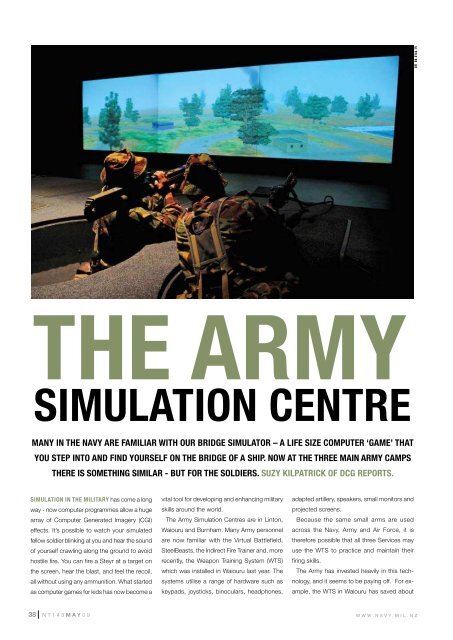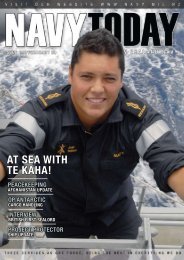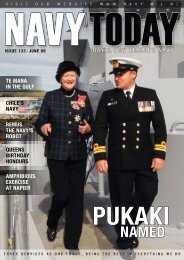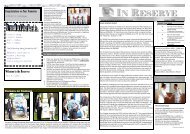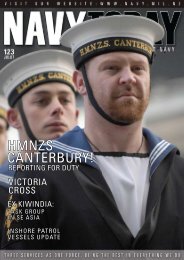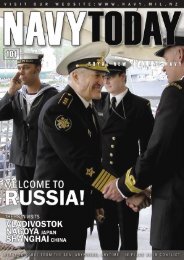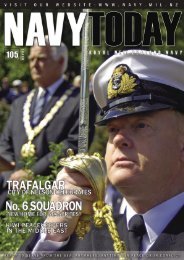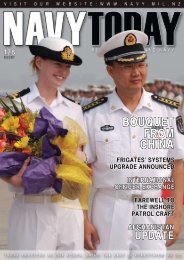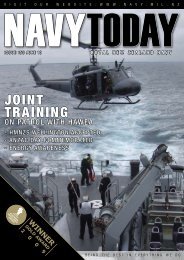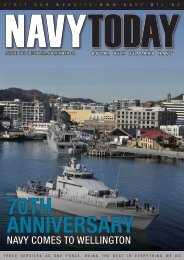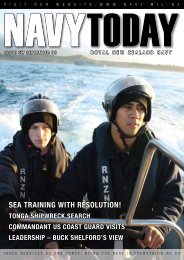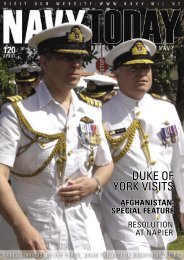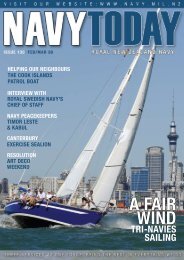Navy Today May 09 | Issue 143 - Royal New Zealand Navy
Navy Today May 09 | Issue 143 - Royal New Zealand Navy
Navy Today May 09 | Issue 143 - Royal New Zealand Navy
You also want an ePaper? Increase the reach of your titles
YUMPU automatically turns print PDFs into web optimized ePapers that Google loves.
JOINT FORCES<br />
OH 08-0144-15<br />
$12 million in live ammunition costs by replacing<br />
it with the virtual kind. But the benefits of<br />
the Army Simulation Centres are not just cost<br />
savings.<br />
‘You can play a whole scenario. In some<br />
countries it’s normal for everyone to carry a gun<br />
– this doesn’t mean they are a threat. Simulation<br />
can help soldiers make better decisions<br />
faster in this kind of environment,’ says MAJ<br />
Peter Curran, commanding the Army Simulation<br />
Centre. ‘You can use night time scenarios,<br />
or simulate bad weather; see vehicles of other<br />
armies or fire specific weapons. You can visit<br />
places on the other side of the world that are<br />
created so realistically, you would know your<br />
way around when you got there in person.’<br />
‘Scenarios must underpin the respective<br />
unit’s mission essential tasks – otherwise<br />
the training is pointless,’ says MAJ Curran.<br />
“Training for operations is not a game and if<br />
you come to the Simulation Centre for training<br />
you’d better be prepared take it seriously.”<br />
Soldiers using weapons at the WTS range<br />
need to show the same consideration for<br />
safety that they would normally. If soldiers are<br />
allowed to adopt bad habits using simulated<br />
weapons there is a danger that this will translate<br />
into live firing and this is to be avoided at<br />
all costs. In real life ammunition and fuel is restricted<br />
and death and injuries are permanent.<br />
It’s about giving soldiers and commanders an<br />
understanding of their actions by putting them<br />
into a range of challenging life or death virtual<br />
situations that can not otherwise be replicated<br />
in the real world<br />
MAJ Curran explains, ‘the value of simulation<br />
is exponential and the benefits of using it are<br />
significant and cost effective.<br />
‘We have been preoccupied with the technical<br />
part – the software and hardware – but<br />
now need to focus on the tactical application<br />
of simulation and start including it in training,<br />
as well as in instructor training. Simulation is<br />
like a Porsche, which until now, has been kept<br />
in the garage; we’re going to dust it off, take<br />
it out on the road and see how fast we can<br />
make it go…’<br />
ARMY RESERVES<br />
GAIN AN INSIGHT<br />
INTO NAVY LIFE<br />
THE ARMY<br />
simulation centre<br />
By LT Jeremy Seed,<br />
3 Auck North<br />
Many in the <strong>Navy</strong> are familiar with our Bridge Simulator – a life size computer ‘game’ that<br />
you step into and find yourself on the bridge of a ship. Now at the three main Army camps<br />
there is something similar - but for the soldiers. Suzy Kilpatrick of DCG reports.<br />
Simulation in the military has come a long<br />
way - now computer programmes allow a huge<br />
array of Computer Generated Imagery (CGI)<br />
effects. It’s possible to watch your simulated<br />
fellow soldier blinking at you and hear the sound<br />
of yourself crawling along the ground to avoid<br />
hostile fire. You can fire a Steyr at a target on<br />
the screen, hear the blast, and feel the recoil,<br />
all without using any ammunition. What started<br />
as computer games for kids has now become a<br />
vital tool for developing and enhancing military<br />
skills around the world.<br />
The Army Simulation Centres are in Linton,<br />
Waiouru and Burnham. Many Army personnel<br />
are now familiar with the Virtual Battlefield,<br />
SteelBeasts, the Indirect Fire Trainer and, more<br />
recently, the Weapon Training System (WTS)<br />
which was installed in Waiouru last year. The<br />
systems utilise a range of hardware such as<br />
keypads, joysticks, binoculars, headphones,<br />
adapted artillery, speakers, small monitors and<br />
projected screens.<br />
Because the same small arms are used<br />
across the <strong>Navy</strong>, Army and Air Force, it is<br />
therefore possible that all three Services may<br />
use the WTS to practice and maintain their<br />
firing skills.<br />
The Army has invested heavily in this technology,<br />
and it seems to be paying off. For example,<br />
the WTS in Waiouru has saved about<br />
Members of the ship’s company of<br />
HMNZS Philomel could be forgiven<br />
for thinking their base had been<br />
taken over by the Army in February,<br />
when fifty-five soldiers descended<br />
on Devonport. The soldiers were<br />
from the 3rd Auckland Northland<br />
Battalion (3 Auck North), <strong>Royal</strong> <strong>New</strong><br />
<strong>Zealand</strong> Infantry Regiment, a Territorial<br />
Force (TF) unit based in Grey<br />
Lynn, Auckland. The officers and senior<br />
NCOs of the Battalion marched<br />
aboard Philomel for eight days of<br />
instruction on the newly introduced<br />
Army Leadership Framework and,<br />
to complete physical competency<br />
tests.<br />
3 Auck North Commanding Officer,<br />
LTCOL Chris Powell said Philomel<br />
provided an ideal location for the<br />
battalion’s training activities. “Philomel’s<br />
messing, accommodation and<br />
classroom facilities gave us an ideal<br />
location close to our headquarters<br />
and easy to travel to for our person-<br />
After the battle efficiency test: LTCOL Powell, WOMM Mick OCarroll<br />
(who proved he can keep up with the Army!) & WO1 Grant Payton<br />
nel. The added advantage of a large<br />
military establishment like Philomel is<br />
that TF personnel snap straight into a<br />
regimental mind-set when they march in.<br />
That meant that with only eight days we<br />
could fit as much training as we wanted<br />
to into that time and we knew the team<br />
would be motivated and focused from<br />
day one”, said LTCOL Powell.<br />
While the classroom- based activities<br />
kept the Battalion’s command element<br />
busy, they also took time out of their<br />
training schedule to take a guided tour<br />
of HMNZS Canterbury. The training<br />
finished on 14 February with a Battle<br />
Efficiency Test which saw the soldiers<br />
march 12 km carrying full equipment<br />
then undertake a series of physical<br />
tests.<br />
They marked the end of their Annual<br />
Field Exercise with a BBQ. “AFE was<br />
a resounding success and the hospitality<br />
we received from Philomel’s<br />
company went a long way to making<br />
it the success it was. Living on board<br />
enabled Battalion members to get<br />
an insight into <strong>Navy</strong> life and culture<br />
and this was the first time many of<br />
our personnel had experience of the<br />
<strong>Navy</strong>. Exposure to the <strong>Navy</strong> in this<br />
way has had an extremely positive<br />
impact and increased the understanding<br />
and awareness amongst all<br />
our attendees,” said LTCOL Powell.<br />
38 NT<strong>143</strong>MAY<strong>09</strong> WWW.NAVY.MIL.NZ<br />
WWW.NAVY.MIL.NZ NT<strong>143</strong>MAY<strong>09</strong> 39


